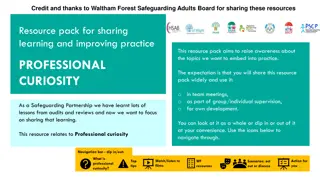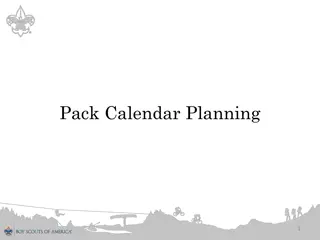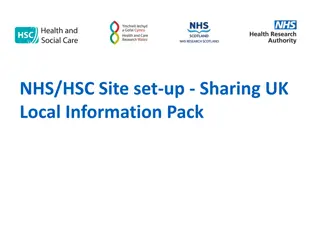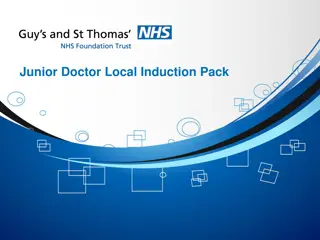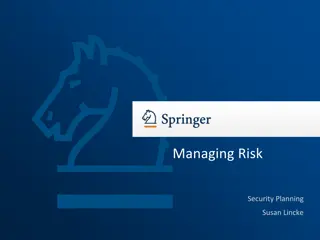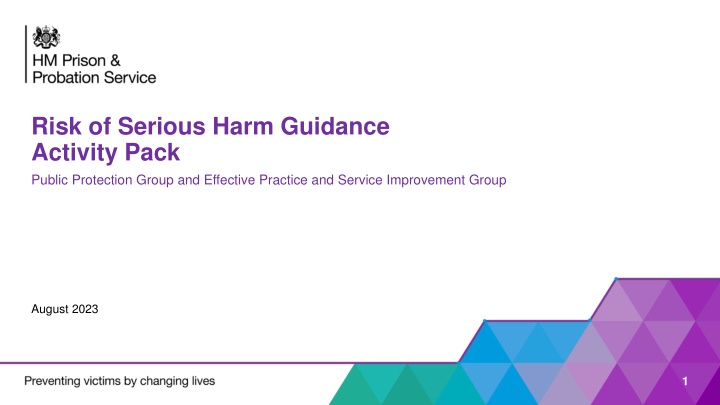
Effective Risk Assessment and Management Practices for Public Protection Groups
Explore the importance of risk assessment and management in ensuring public safety. Understand the definition of risk, why risk levels and categories are utilized, and what constitutes a good risk assessment. Dive into the significance of fair, evidence-based assessments and the value of descriptive and analytical writing in producing comprehensive risk assessments.
Download Presentation

Please find below an Image/Link to download the presentation.
The content on the website is provided AS IS for your information and personal use only. It may not be sold, licensed, or shared on other websites without obtaining consent from the author. If you encounter any issues during the download, it is possible that the publisher has removed the file from their server.
You are allowed to download the files provided on this website for personal or commercial use, subject to the condition that they are used lawfully. All files are the property of their respective owners.
The content on the website is provided AS IS for your information and personal use only. It may not be sold, licensed, or shared on other websites without obtaining consent from the author.
E N D
Presentation Transcript
Risk of Serious Harm Guidance Activity Pack Public Protection Group and Effective Practice and Service Improvement Group August 2023 1
Risk assessment Definition & Risk Assessment OASys defines serious harm as: An event which is life threatening and/or traumatic and from which recovery, whether physical or psychological, can be expected to be difficult or impossible. 2
Risk assessment Discussion What is the definition of risk? Consider the concept of risk outside probation. Why do we assess risk in probation? Why do we use risk levels? i.e. Very High, High, Medium, Low. Why do we use risk categories? i.e. public, known adult, children, staff, prisoners. What are static risk factors? What are dynamic risk factors? 3
What makes a good risk assessment? To develop an accurate and evidence-based risk assessment and risk management plan, information must be obtained from reliable sources. Each piece of information must be considered and fully understood and appropriately applied to meet the objective. Incomplete information or incomplete understanding of terms can lead to erroneous assumptions which can undermine an accurate assessment. 4
Activity Read through the below and discuss each of the words and phrases highlighted in bold. What do they each mean and why are they important? A good risk assessment is fair taking into account factors thatmitigate risks as well as those that might increase it. Avoiding bias is an important feature of a good risk assessment, and involves recognising any bias you hold, acknowledging it and taking steps to mitigate it. A good risk assessment is evidence based.It uses statistical evidence informed by research to identify likely risk factors for the type of offending, and is also individualised. Good risk A solid rationale is the centrepiece of good risk assessment. It explains why specific conclusions are drawn and makes logical sense based on the evidence. Understand the person you are assessing. Build a deep understanding of the individual s behaviour and the factors which contribute towards offending. assessments form the foundations of a risk management plan that include supportive and restrictivemeasures to reduce the risk and impact of further harm. Good assessments are those which use a variety of sources of information, which are analysed and validated where possible. 5
Description and Analysis Whilst descriptive writing is a necessary element of risk assessments, analysis of information is equally important to produce a full risk assessment. Explain your analysis by investigating and evaluatingthe significance of events. In other words, analytical writing demonstrates the why , how , and so what . Consider how the prompts below apply to risk assessments then move onto the activity. Analytical writing Descriptive writing Identifies the significance States what happened Weighs one piece of information against another Gives the story so far Makes reasoned judgements States the order in which things happened Identifies why the timing is important Says whether and when something occurred Gives reasons for the selection of each option States options Evaluates the relative significance of details Lists details Structures information in order of importance Lists in any order Highlights the relevance of links between pieces of information States links between items Draws reasoned conclusions Gives information 6
Activity - Case A Identify limitations of providing only description within an assessment. Read the assessment extracts and highlight in yellow the lines which are descriptive and highlight in blue the lines which are analysis. Feedback and discuss findings. Mr A has demonstrated the capacity to cause serious physical harm, given a number of his convictions are for assaulting his partner, which on one occasion resulted in the fracture of the victim s forearm. Mr A s pattern of offending is linked to periods of substance misuse. From looking at previous assessments, it is clear that he has a long-standing history of Class A substance misuse and has received intensive treatment including several months in a residential rehabilitation centre. Previously, Mr A has minimised his substance misuse issues, often denying any use and suggesting that his peers and even Police were planting the drugs on him. Although it is positive that he is currently expressing motivation to engage with drug services, I have concerns that he is underestimating the difficulty he will have in maintaining abstinence. I assess that, therefore, a relapse into drug use is currently likely and will become an acute risk factor. In such circumstances, the risk posed to his partner will increase. 7
Bias in risk assessment Hazel Kemshall: We make judgements based on assumptions, we add in information where stories are incomplete, we assess on what we don t know and don t ask about and there is a reluctance to change one s mind in the face of new information . Types of Bias Conscious and unconscious discrimination can be about class, gender, race, sexuality or beliefs about the proper demeanour of the individual. Use of invalid models, for example an understanding of behaviour drawn from the media rather than reliable and validated research. The beliefs of the assessor around different types of offending. It could also be beliefs around their ability to work effectively with a particular offence type or individual. Unreal optimism is wanting to believe there are signs of positive progress being made by an individual. Unreal pessimism is refusing to see positive signs of progress and change. Being afraid of an individual. Representative bias is assuming knowledge of one individual of a particular group means you know about all individuals within that group. Confirmation bias is only paying attention to information that supports the judgement you have already reached. Availability bias is over reliance on information easily obtained. Familiarity bias is feeling comfortable with situations or people with whom we are familiar, and wary of those we are not. Present bias is prioritising short-term goals over longer-term gains. 8
Risk Management Planning The Four Pillars 9
The Four Pillars The Four Pillars Risk management is taking action to address the risk presented by a person, reducing the likelihood of serious harm occurring and reducing the potential impact of any such harm The Four Pillars approach to risk management by Hazel Kemshall is designed to build a risk management plan which is proportionate, transparent and responsive to the identified risks. Interventions and Treatment Monitoring and Control Supervision Victim Safety The approach provides a holistic picture of risk with structure and active risk management, incorporating various agencies in the supervision of a case collectively working towards positive change and achieving desistance. 10
Supervision Quick Fire Questions Watch the short video on the Supervision pillar. 1. What is the main purpose of the supervision pillar? 2. True or False? The supervision pillar relates to statutory supervision only. 3. What method of supervision must be recorded under every risk management plan? 4. List 3 types of agencies/activity that could be referred to under the supervision pillar? 5. Why is it important that the frequency of contact is matched to the level of risk? 11
Monitoring and Control Quick Fire Questions Watch the short video on the Monitoring and Control pillar. 1. What is the purpose of monitoring activity? 2. Professor Hazel Kemshall refers to this pillar as watch and warn . What 3 things must be done in order to do that? 3. Why are controls put in place? 4. Give 2 examples of monitoring in the community and 2 for custody and why they might be used. 5. Name a statutory order that can be used as a form of monitoring and control. 12
Interventions and Treatment Quick Fire Questions Watch the short video on the Interventions and Treatment pillar. 1. What is the focus of the Interventions and Treatment pillar? 2. What is meant by the term sequencing of interventions and why is it important? 3. How does the Good Lives Model approach support engagement? 4. Give 2 examples of types of intervention/treatment for addressing internal factors. 5. What licence conditions/order requirements could be recorded under this pillar? 13
Victim Safety Planning Quick Fire Questions Watch the short video on the Victim Safety Planning pillar. 1. What is the focus of the Victim Safety Planning pillar? 2. Who do we mean by victims in terms of this pillar? 3. Do we reference potential future partners of a domestic abuse perpetrator in this section? 4. Give 2 examples of victim safety actions. 5. Give two examples of safeguarding measures for a custody RMP. 14
Further resources Risk of Serious Harm Guidance 2020 ROSH Risk EQUIP page Four-step process 7 minute briefings Risk of Serious Recidivism User Guidance 15




